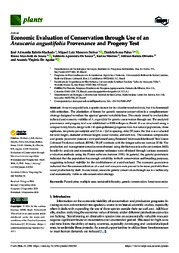Economic evaluation of conservation through use of an Araucaria angustifolia provenance and progeny test.
Economic evaluation of conservation through use of an Araucaria angustifolia provenance and progeny test.
Author(s): MACHADO, J. A. R.; FREITAS, M. M.; PAIVA, D. I.; SOUZA, B. M. de; SOUSA, V. A. de; MARTINS, K.; OLIVEIRA, E. B. de; AGUIAR, A. V. de
Summary: Araucaria angustifolia is a species known for its valuable wood and nuts, but it is threatened with extinction. The plantation of forests for genetic resource conservation is a complementary strategy designed to reduce the species’ genetic variability loss. This study aimed to evaluate the technical and economic viability of A. angustifolia for genetic conservation through use. The analyzed provenance and progeny trial was established in 1982 in Itapeva, Brazil. It was structured using a compact family blocks design with 110 open-pollinated progenies from five natural populations, three replicates, ten plants per subplot, and 3.0 m × 2.0 m spacing. After 33 years, the trial was evaluated for total height, diameter at breast height, wood volume, and survival. The variance components and genetic parameter estimates were performed using Restricted Maximum Likelihood/Best Linear Unbiased Prediction methods (REML/BLUP) methods with the Selegen software (version 2014). The production and management scenarios were obtained using the SisAraucaria software (version 2003). Sensitivity analysis and economic parameter estimates were obtained through various economic evaluation methods using the Planin software (version 1995). In general, the genetic parameters indicated that the population has enough variability for both conservation and breeding purposes, suggesting technical viability for the establishment of a seed orchard. The economic parameters indicated that the commercialization of wood and araucaria nuts proved to be more profitable than wood production by itself. In conclusion, araucaria genetic conservation through use is a technically and economically viable ex situ conservation strategy.
Publication year: 2024
Types of publication: Journal article
Unit: Embrapa Forestry
Observation
Some of Embrapa's publications are published as ePub files. To read them, use or download one of the following free software options to your computer or mobile device. Android: Google Play Books; IOS: iBooks; Windows and Linux: Calibre.
Access other publications
Access the Agricultural Research Database (BDPA) to consult Embrapa's full library collection and records.
Visit Embrapa Bookstore to purchase books and other publications sold by Embrapa.

